Don’t fret. Instead, focus on what you can control about the returns process so you can save money, deliver an amazing customer experience, and avoid Amazon account suspension.
Today, I’m going to answer the 13 most critical questions about Amazon returns and refunds and show you how to create streamlined return systems so that you can grow your Amazon business with confidence.
By the way, today’s training contains a fraction of what we teach in our GROW course. GROW is the fifth of five courses offered in our Amazon FBA Mastery membership, where Just One Dime trains you step-by-step how to build your business on Amazon.
1. How do Amazon returns affect your seller account health?
Amazon returns and refunds are a part of customer service.
When you provide customer service, shoppers can leave you positive or negative seller account feedback.
Unlike product reviews, seller account feedback is not displayed on your Amazon listing. Instead, it’s displayed directly on your account.

Seller account feedback has a huge impact on your Amazon seller account health. Therefore, how you handle returns and refunds has a huge impact on your Amazon seller account health.

For example, let’s say you sell a full body massage chair recliner. One day, a buyer reaches out to you saying that it stopped working.
If you ignore the message or refuse to help, saying something that amounts to “Sucks to be you,” then the shopper may leave negative feedback on your Amazon seller account, putting your account in jeopardy over the price of one product.
But instead, if you acknowledge their problem with empathy, apologize if it’s your fault, and make the situation right with a replacement or refund, then they may leave positive feedback on your account. Sure, it might cost you more, but you’ll be doing the right thing for your business.
We go a lot more in-depth about how to keep your Amazon account healthy in our Amazon FBA Mastery membership—including how to remove 70% of all negative seller feedback.
If you fail to keep your Amazon seller account healthy, you make it:
- Less likely you can get ungated to sell in certain product categories
- Less likely that you can gain access to Amazon special programs
- Less likely that Amazon will side with you in the case of disputes
- More likely that your account will get suspended or terminated

Are there shoppers that will take advantage of your benevolence? Absolutely. I understand that you don’t want to reward bad behavior, but don’t put your Amazon account in jeopardy to make a stand over the cost of one product.
This is just one reason why we encourage you to be generous with how you handle returns.
Not only that, but if you get caught up in the minutiae of fighting returns, it wastes your time. Focus that energy on building your business.
2. What are the 12 reasons why Amazon shoppers can return your product?
When shoppers return an item, Amazon gives them a list of reasons to choose from.
- No longer needed
- Inaccurate website description
- Item defective or doesn’t work
- Bought by mistake
- Better price available
- Product damaged, but shipping box OK
- Item arrived too late
- Missing or broken parts
- Product and shipping box both damaged
- Wrong item was sent
- Received extra item I didn’t buy
- Didn’t approve purchase

While Amazon only gives shoppers these 12 reasons to pick from, technically, there are 72 reason codes why a shopper returned your item. I’ll spare you from the whole list, but if you’re interested, you can view the full list here.
Track down why any shopper returned your product and view it as an opportunity to be a better seller.
You have control over most of the reasons on this list.
It’s not going to help you to blame shoppers. Yes, some of those reasons boil down to buyer’s remorse. But instead, change your mindset to, “What could I have done to prevent this return?” Then, act on it.
For example, if you get returns on your massage chair saying the chair was too big for their living space, that means you need a product photo showing how large the chair is relative to a living room.
3. How can you see the reasons why shoppers returned your Amazon FBA products?
Go to Seller Central and click the top left corner with the three horizontal lines.

Hover over Reports, and click Fulfillment.
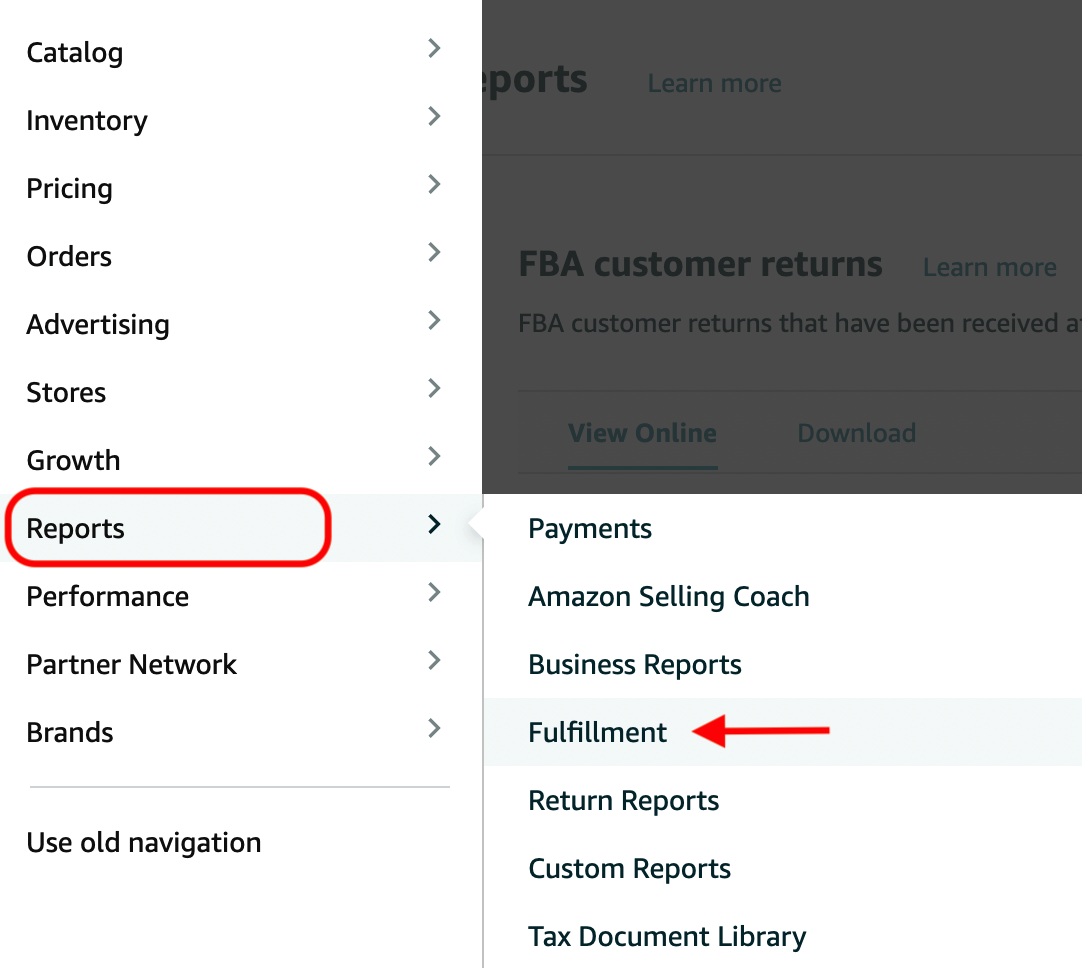
Scroll down. Under Customer Concessions, click FBA customer returns.
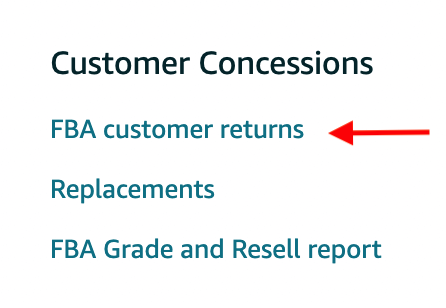
Here you’ll see the customer return reasons.

In order to see notes that the customer left on the return, you have to download an FBA customer returns report.
On the same page, under FBA customer returns, click Download.

Under Event Date, set the time period for your report.

Click Request .csv Download to download your report as a spreadsheet.

Once Amazon has finished processing, under Report Status, click Download.

Open your report. Scroll to the far right side of the document to see customer comments.
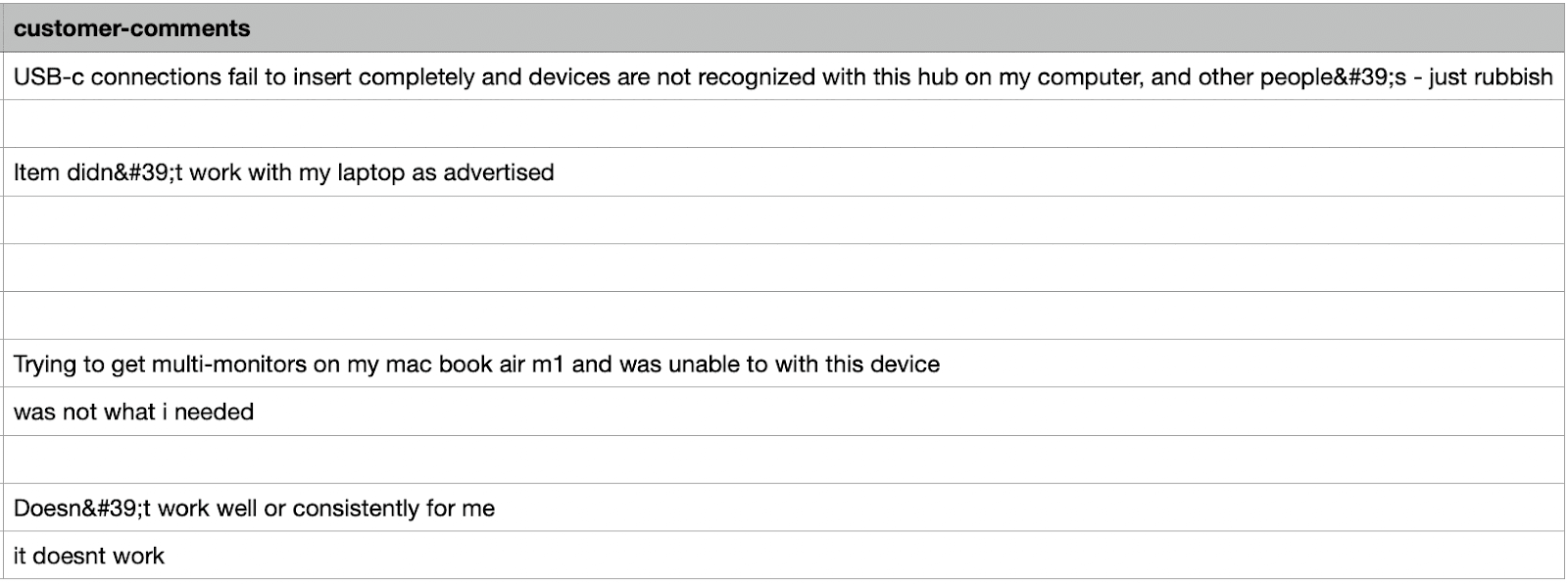
According to the customer comments above, some shoppers are getting faulty items. If this were your product, you should see if you can get your hands on these units and test them to find out if they really don’t work or if the problem was on the shoppers’ end.
Most types of products are bound to have a few duds in the bunch.
The question is: What’s the failure rate? That’s why it’s important to have an acceptable failure rate outlined in your supplier contract and hire a third party to inspect your product after production. We show you exactly how to do that in our Amazon FBA Mastery membership.
4. How Do Amazon FBM Returns and Refunds Work?
When you sell FBM, you need to provide a return address in Seller Central.
FBM means “fulfillment by merchant”. You are the merchant. When you choose FBM, you are storing and shipping units to your buyers without Amazon services. You can either store units at your home and slap shipping labels on the boxes yourself, or you can hire a third party logistics (3PL) company to do the storage and shipping for you.
That also means when FBM returns happen, the products don’t go to Amazon; they go to the address you provide Amazon.
You can set your own FBM returns policy in Amazon Seller Central. However, Amazon limits you to certain FBM return policy options depending on which market(s) you sell in.
For example, if you sell in the United States, Amazon will automatically approve and process all FBM returns except for items that are:
- Handmade
- Amazon Custom
- Sexual wellness
- Certified Pre-Owned Watches
- Professional Medical Supplies
- Professional Dental Supplies
- Non-physical items (digital software, warranties, etc)
- Items that are non-returnable by law and dangerous goods
- Heavy and bulky items

Amazon will only have you manually review return requests for items in the above list.
So, if you sell a heavy and bulky massage chair, it’s exempt from the prepaid returns process. Amazon will ask you to review return requests for that product.
However, if you sell a much smaller product like a neck massager, Amazon will process the return automatically.
Additionally, Amazon will automatically give shoppers a prepaid return shipping label when they want to return your product.
5. How does the Amazon FBM prepaid return process work?
Let’s say Bobby McGee wants to return a neck massager he bought from you. He says he thought it was battery charged, but really the product needs to be plugged in. Since it’s not an exempt product, Amazon automatically approves his return and gives him a prepaid shipping label to return the product via the USPS. Once Bobby brings the package to USPS, it’s shipped straight to your address.
There are no if/thens, no waiting for someone to print this or approve that—just pure automation.
This takes the guesswork out of returns for the shopper, seller, and Amazon. We all just saved time.
Amazon has now forced FBM returns in the US to be as seamless and easy as FBA returns, making customers ecstatic. That’s why Amazon succeeds: they put the customer first.
You may object and say, “But that hurts sellers.”
Yes, that would hurt sellers who live on razor thin margins. Everyone else? We’re fine. Handmade sellers are protected, 40%+ margin sellers are good, and we all have happy shoppers. By the way, we will show you how to find a product with 40%+ profit margins in our Amazon FBA Mastery membership.
Not only that, but since Amazon is so shopper friendly, Amazon continues to grow its shopper base, and that brings third-party sellers even more shoppers.
Instead of quibbling on every return, focus on the things you can control and give the shopper a reason to love your product so much that they would never dream of returning it.
If you sell in the US from abroad, you must either provide a US local shipping address, pre-pay for international shipping, or offer returnless refunds.
6. How do you set up your automatic FBM return system?
In Seller Central, click on the Settings gear symbol.

Click Return Settings.

From here, you can edit your return settings. By default, it will show you your general settings.
Set up your general settings.
If you sell in the US marketplace, you won’t be able to edit either of these settings:
- I want Amazon to automatically authorize all return requests that meet Amazon policy.
- I want Amazon to provide a prepaid shipping label when eligible and in Amazon policy.
You used to be able to set your own return window and have the ability to accept or reject returns yourself, but Amazon removed those options as you can see on the image below.
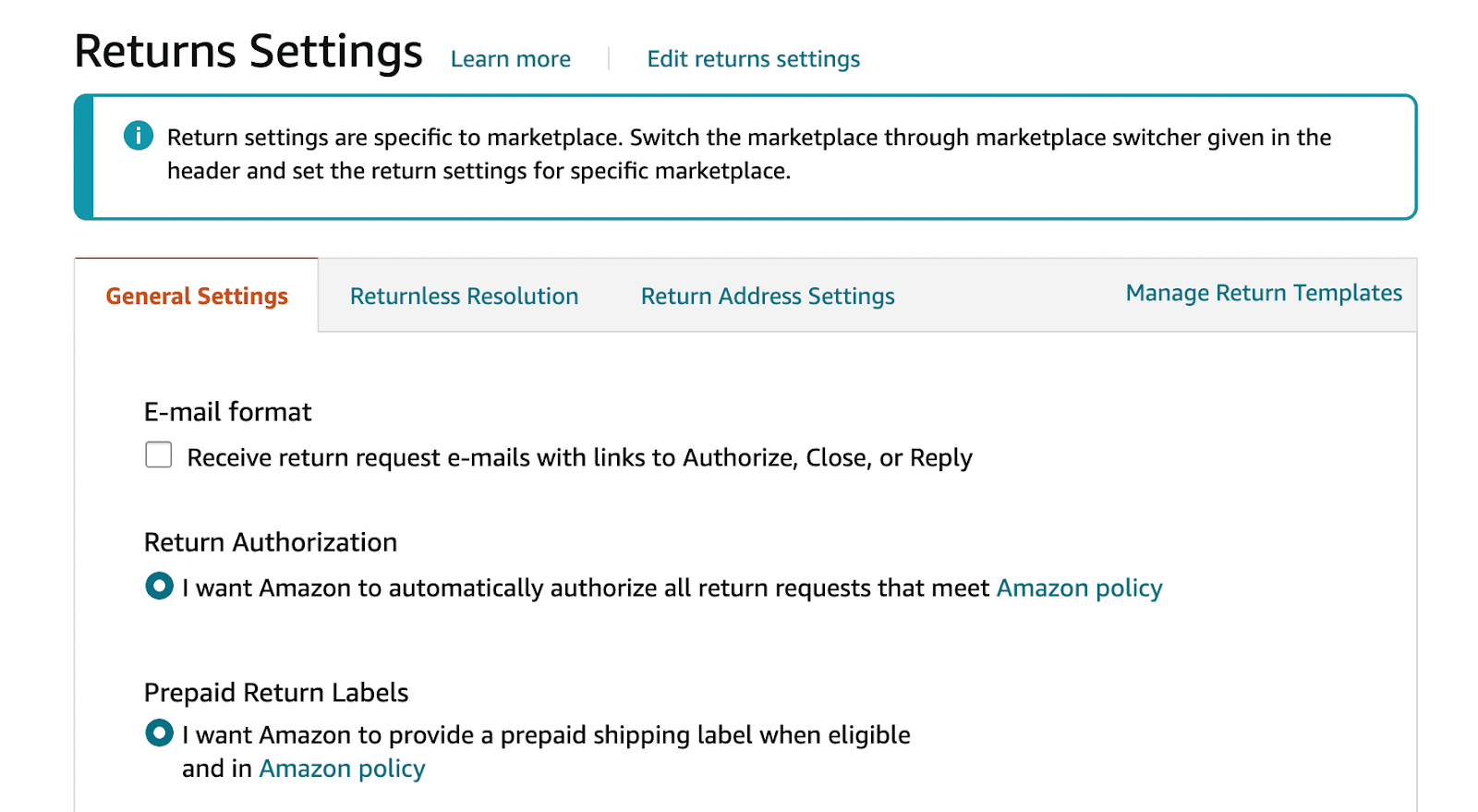
For products exempt from the prepaid returns policy, Amazon will give you the option to either have Amazon provide an unpaid mailing label (and have shoppers pay for shipping) or have you provide a prepaid mailing label.

Amazon will also give you the option to provide a Return Merchandise Authorization (RMA) number or have Amazon provide one for you. An RMA is essentially a number you assign to a return package to identify it and tell your warehouse what to do with it.

Set up your returnless resolution policy.
Click on Returnless Resolution to set your own returnless refund policy.

There may be times where you don’t want the product back. For example, if your neck massager caught fire, you probably don’t want it back.
So, if you want to issue a refund without getting the product back, issue a “returnless resolution" refund.
To set your own returnless refund policy, click Add New rule.

From here, you can set your returnless resolution policy to only be good for your products in certain categories, price ranges, and set reasons why you would approve a returnless refund.
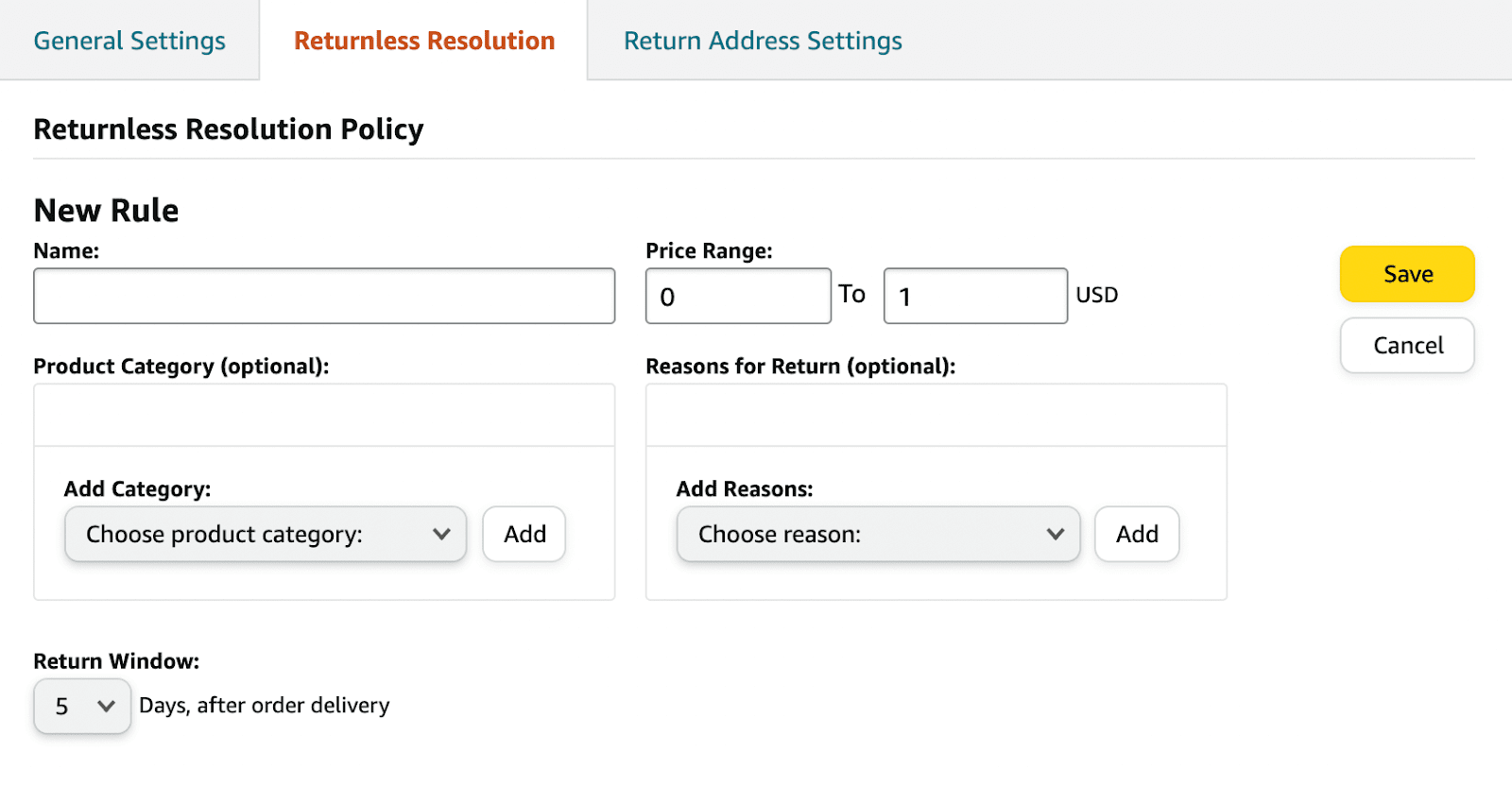
Edit your return address settings.
Click Return Address Settings to set your return address.

You can create a separate return address for each Amazon marketplace and change your default return address.

7. How do you manage your other FBM returns?
To manage all your manual FBM return orders, go to Seller Central and click the top left corner with the three horizontal lines.

Under Orders, click Manage Returns.

From here you can manually authorize returns.
Unless you sell a product that’s exempt from the prepaid returns process, like a heavy and bulky massage chair, you probably won’t have to worry about this part.
Amazon requires you to respond to all manual return requests within 24 hours. You also have to issue the refund within two business days of getting the package. If you don’t, Amazon will step in and charge your account.
Get your free customer returns chart to see our recommendations for how you should respond to return requests at jod.com/returns.
8. Where does the money go during FBM refunds?
When FBM returns and refunds are issued, then the following will happen:
- Every cent you would have made from the sale goes back to the customer.
- You pay for the pre-paid return shipping label. Amazon pulls these funds from your account.
- You get refunded the referral fee you paid to Amazon (for facilitating the sale).
- Amazon will charge you a refund administration fee.
The refund administration fee is either $5 or 20% of the referral fee on the order—whichever is less.
For example, let’s say you sell a $100 neck massager. Whenever you sell it, Amazon charges you a 15% referral fee.
One day a shopper buys your neck massager. You pay Amazon $15 in referral fees. Then, the shopper complains in a one-star review that it stopped working. You offer a replacement, but they don’t want one. So, you issue a refund in hopes that they’ll change the review.
For that refund on the neck massager, Amazon will credit you back most of the $15 referral fee, but Amazon will retain 20% of that fee as the refund administration fee, which is $3.
The refund administration fee maxes out at $5. So, what if you instead sold a massage chair for $500?
- The referral fee is 15% of $500, which is $75.
- The refund administration fee would be 20% of that $75, which is $15.
- Because the refund administration fee maxes out at $5, you only pay Amazon $5 instead of $15 for processing that return.
So, once the return and the refund are done:
- The shopper has their $500 back.
- You can opt to pay for the return shipping or have the shopper pay for the return shipping because it is a pre-paid label exempt product.
- You have your $500 massage chair back.
- You have the $75 referral fee back.
- You paid Amazon the $5 return processing fee.
Check out our complete breakout of all the various Amazon fees you may encounter at jod.com/amazonfees.
9. How do Amazon FBA returns and refunds work?
FBA means “fulfillment by amazon”. Here, you pay Amazon to fulfill each order for you.
Amazon stores your inventory in fulfillment centers, and every time a shopper clicks “buy”, Amazon sends the package to the shopper’s door. Plus, Amazon handles most customer service for you.
If you have Amazon fulfill your orders for you, then Amazon will take care of the return and refund process for you.
Shoppers usually have 30 days to return FBA products to Amazon.
During the holiday season, shoppers have even more time to return FBA products. If a shopper buys an FBA product from October 1st through December 31st, then they have until January 31st the next year to return the item.
Amazon won’t accept returns for certain products. However, Amazon may still issue the refund if the shopper takes a picture that shows the problem with the item.
Amazon will not accept FBA returns for:
- Computer laptops, desktops, and Kindles more than 30 days after delivery
- Items classified as hazardous materials or that use flammable liquids or gases
- Any product missing the serial number or UPC
- Downloadable software products
- Online subscriptions after shoppers have accessed them
- Gift cards (except when required by law)
- Prepaid game cards
- Some jewelry orders
- Some health and personal care orders
- Grocery products
- Open software
- Items with special shipping restrictions
- Live insects
See the details for all exceptions here.
When Amazon receives the return, a new process begins.
10. What happens to a product return when it arrives at Amazon fulfillment centers?
First, Amazon determines if the product is still sellable.
Amazon will usually determine if your product is still sellable by considering the shopper’s return reason and the visible condition of the product when they receive it.
If a shopper returns your unopened, unused, completely pristine product to Amazon, and the shopper isn’t claiming that there was something wrong with the product, then there is no question as to whether the item is still sellable. Amazon will throw that unit right back into circulation. For example, if the shopper marked their return reason as “Bought by mistake”, and the package is unopened, Amazon will probably deem the product as sellable.
However, if the shopper’s return reason indicates something is wrong with the product such as “Item defective or doesn’t work”, then Amazon will probably deem the unit as damaged and unsellable.
- If the product is sellable, Amazon will place your unit with the rest of your inventory to be sold one day again.
- If the product is damaged, and Amazon takes responsibility, Amazon will dispose of the product free of charge and credit your account for the sale.
- If the product is damaged, and Amazon does not take responsibility, Amazon will place the unit in your inventory as unfulfillable.
When Amazon takes responsibility, that means they believe it is their fault when your product is damaged.
When your product is damaged, Amazon does not take responsibility, and your unit is unfillable, that means Amazon cannot use that unit to fulfill orders.
You will still get charged for storage fees and long-term storage fees for that unit. Having unfulfillable units remain in fulfillment centers long-term can also damage your account health, so you want to remove them.
You can either choose a removal option for each item individually or put a scalable system in place.
11. How do you set up your automatic unfulfillable removal system?
No surprise I’m for the scalable system. I’d much rather focus on growing my business than be bothered with worrying about unfulfillable inventory.
You can remove your unfulfillable units in one of four ways:
- Refurbishment
- Liquidation
- Returned to you
- Disposal
To make your plan, go to Seller Central. Click on the three horizontal lines in the top left corner.

Under Inventory, select Manage FBA Inventory.
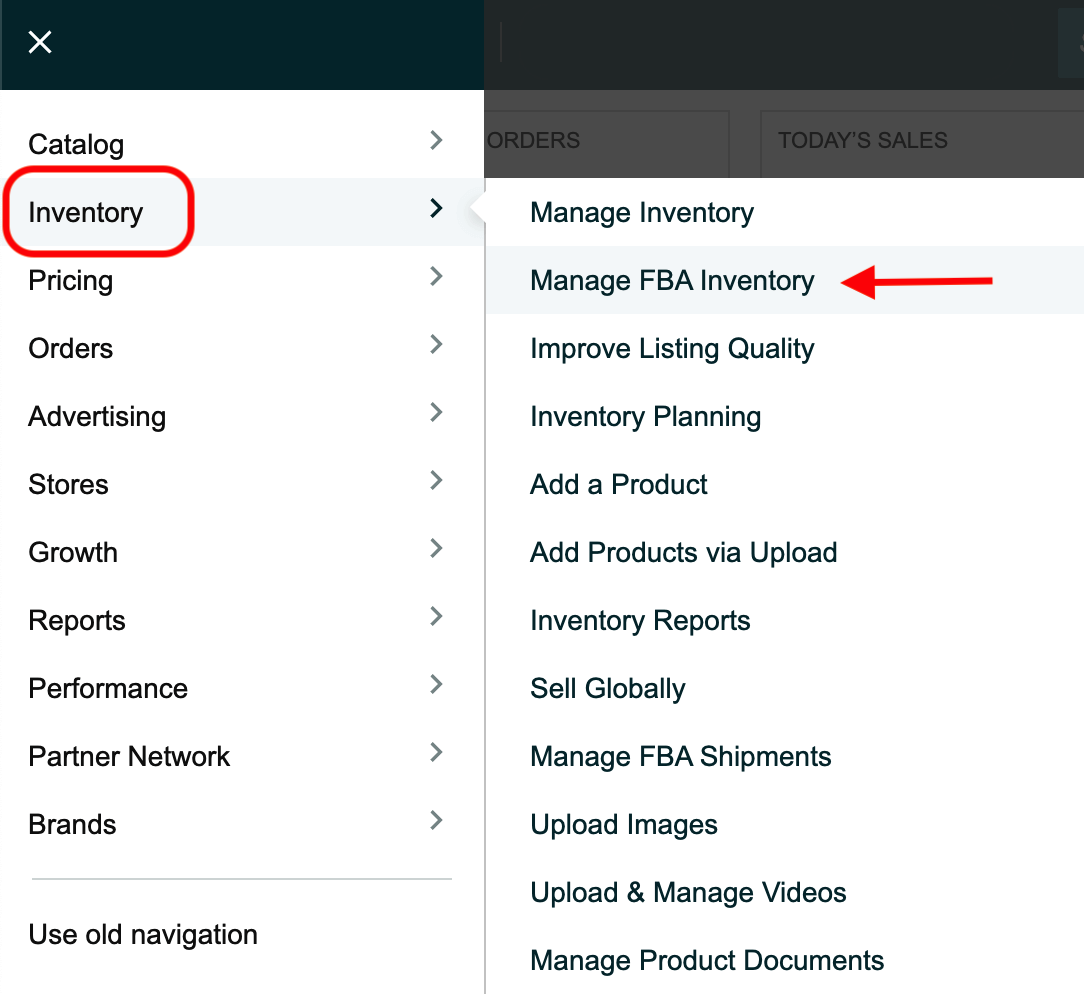
Click Remove Unfulfillable Inventory.

Click Auto Removal Settings.

That will take you to the Automated unfulfillable settings page.
Select Enable if you choose to take advantage of either Amazon’s Refurbishment or Liquidations services.

“Refurbishment” is a misnomer. Amazon’s Refurbishment option is not having Amazon fix up your product but rather to fix your product’s packaging.
This is useful for when a shopper has opened the package and returned the item in unsellable packaging.
For example, if you get your neck massager returned to fulfillment centers not in the original box but instead in a styrofoam cooler meant for food, you can’t go around and sell your neck massager that way. It would look unprofessional. So, Amazon can repackage your neck massager in either branded or unbranded packaging.

If you select Refurbishment, that is the first thing Amazon will try to do.
If a unit can’t be refurbished or if you don’t opt for refurbishing, then Amazon will move on to the possibility of liquidating it.
Amazon Liquidations is when you have Amazon sell your product to a wholesale liquidator.
According to Amazon, products typically liquidate for 5-10% of the selling price, and Amazon will take a cut of that money for facilitating that trade.

If you choose to not have your product refurbished or liquidated, or if Amazon cannot refurbish or manage to liquidate your unit, then you can either have the product returned to you or disposed of for a fee.
This is an either/or situation. You cannot both get your product back and have Amazon dispose of it at the same time.
Amazon will present you with a set of toggling buttons for you to pick one on this page.
Selecting Return means that your “damaged” or “defective” product is returned to you.
Choose this if you want to see for yourself if the product is really unsellable. For example, if a shopper says that your neck massager doesn’t turn on and returns it to Amazon, you can get that unit sent to you. That unit might actually work, and then you can send it back to Amazon as a “new” unit in the original packaging.
If you have a well-versed 3PL team that offers to test returned products for you, that’s one scalable option. When you choose Return, Amazon will ask you for address information.
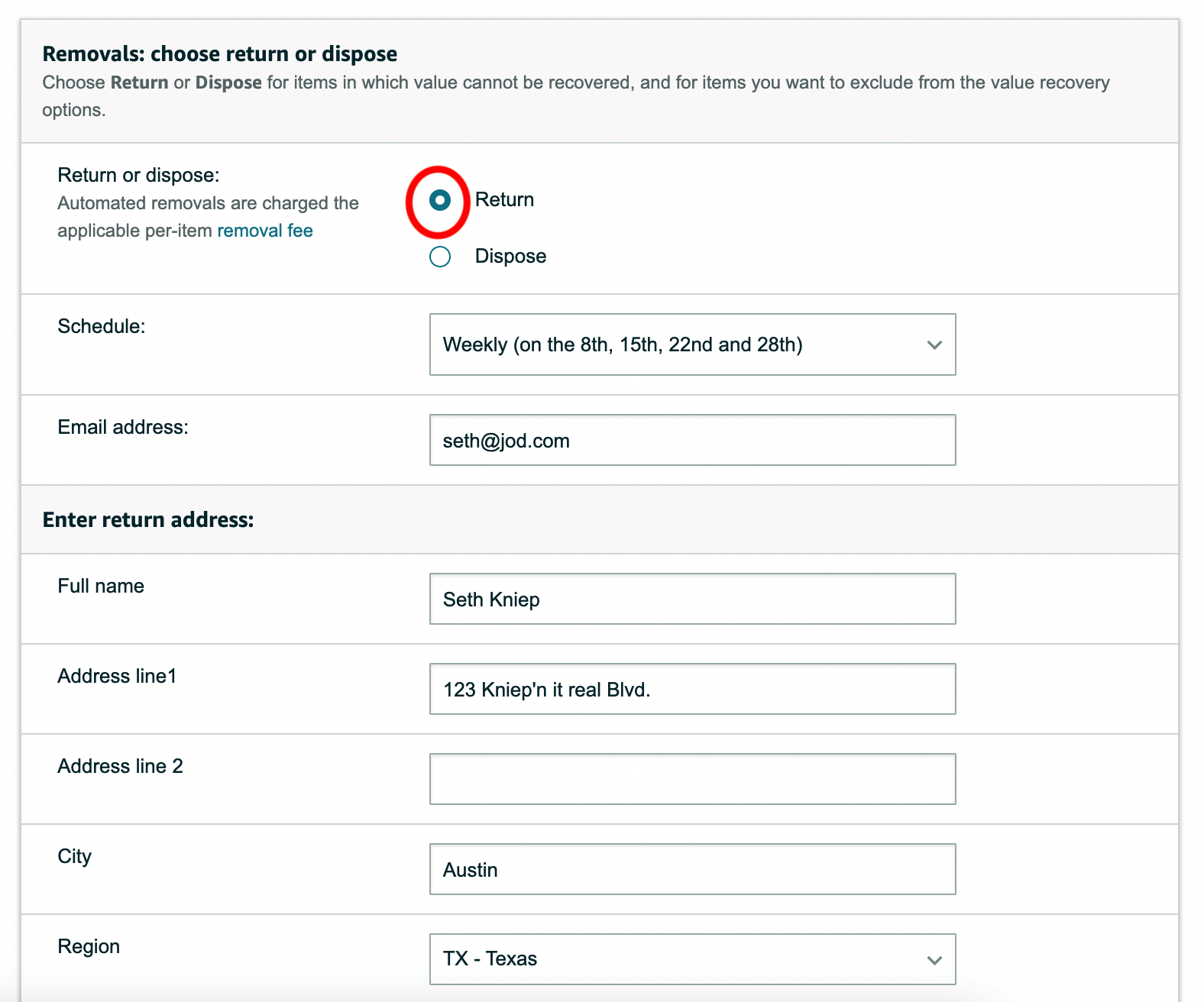
Selecting Dispose means that Amazon is going to put it in the trash, biohazard waste, or into whichever disposal process is right for your product.
You have to pay Amazon to do this unless they’re running a deal.
When you choose either Return or Dispose, you’re going to tell Amazon how often you want your unfulfillable products returned or disposed of. For example, you can have it done weekly.
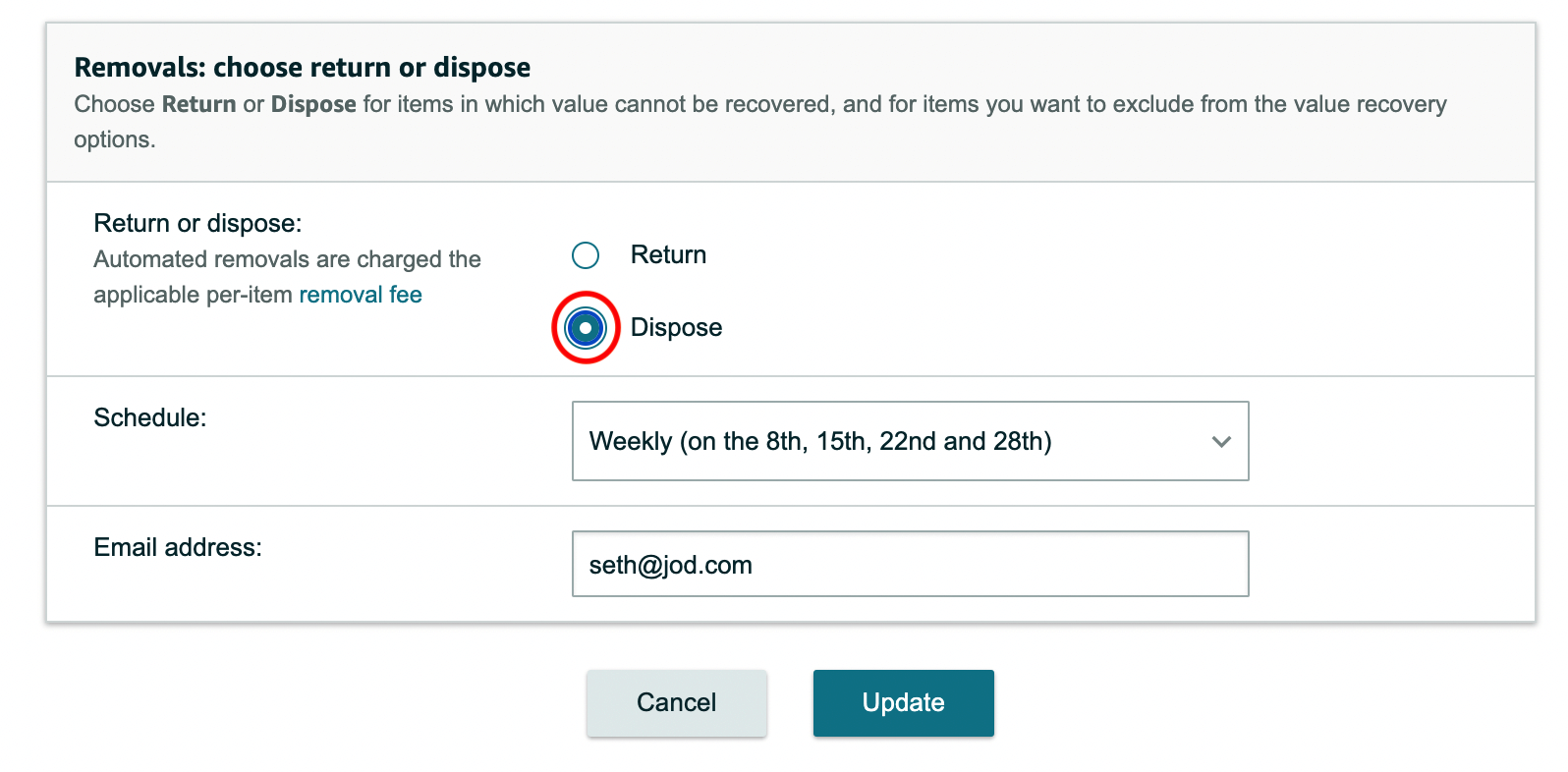
Click Update to save your settings.

And you’ve done it! Your removal system is now fully automated.
12. Can you have Amazon donate your products instead of disposing them?
Yes! In fact, Amazon will first try to donate your products instead of disposing of them when you are enrolled in the Amazon FBA Donations program.
You are automatically enrolled in the Amazon FBA Donations program when you create your account.
When you request Disposal for your product, Amazon will make the unit available to partnered charities. If no charity claims the unit, then it will be thrown away.
There is currently no way to find out how much, if any, of your units were donated instead of disposed of.
Amazon will still charge you the disposal fee when your item is donated.
13. Where does the money go during FBA refunds?
Unless Amazon takes responsibility for your product being damaged (i.e. during fulfillment) and credits your account for the sale, then the following will happen:
- Every cent you would have made from the sale goes back to the customer.
- Amazon will refund you the referral fee.
- Amazon will refund you any taxes you’ve incurred.
- Amazon will not refund you the fulfillment fee.

Additionally, if you sell apparel and shoes, Amazon will charge you a returns processing fee.
This is because Amazon is trying to overcome an objection shoppers have online: They don’t know if the shoe or apparel will fit. Since shoppers often take advantage of free return shipping for shoes and apparel, Amazon will charge you the returns processing fee.
The returns processing fee is based on the product’s size and weight.
To give you an idea of the pricing, if your product fits in the standard size tiers, you will pay between $2.12 and $6.81.
If you were charged a $1.80 variable closing fee upon selling a media item like a book, CD, DVD, or video game, Amazon will not refund you the variable closing fee when the unit is returned.
To view all the money going in and out of your Amazon seller account, download your monthly Amazon payout report in Seller Central. Watch the entire breakdown of the Amazon payout report here.
Warrior, I hope this helped you tremendously. Do you have any more questions about seller returns? Let me know in the comments.
Remember to get your seller returns guide below!

